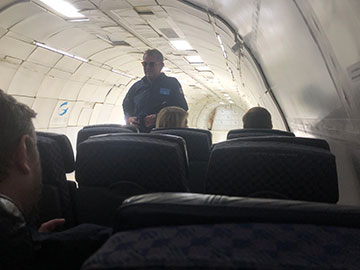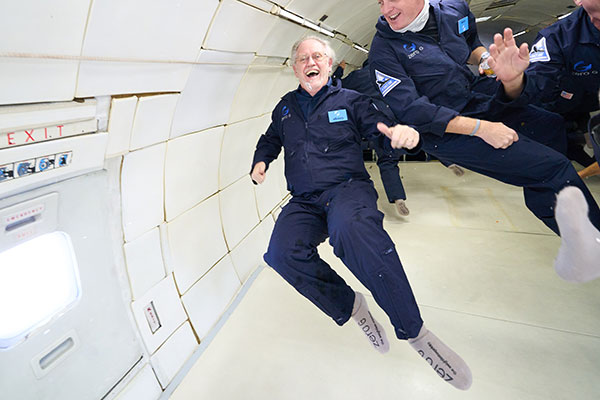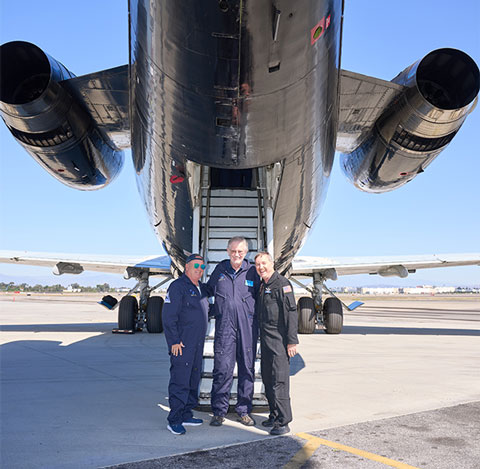Greetings from Palmia Observatory
Well, the wait is finally over. What started as a desire to experience the weightlessness of being in outer space or in orbit, as seen on a Josh Gates Tonight episode way back in December 2020, finally happened.
The recent launches of billionaire astronauts experiencing zero g, on Virgin Galactic, SpaceX and Blue Origin spacecraft, was an inspiration that the rest of us could also experience some weightlessness. So, on October 16, we made our way to Ross Aviation at the Long Beach Airport to meetup with Science Nerd, Scott, to join the weightlessness experience offered by Zero-G Corporation. The company details and lots of videos of previous flights and people tumbling and enjoying the weightless experience can be found at the website: https://www.gozerog.com/.
If you want to see some more description of the parabolic flight path to achieve zero-g flights, check out the blog post of July 31 at: http://www.palmiaobservatory.com/2021/07/commercial-tourists-venture-into-space.html
The first thing we had to get out the way was making sure we were COVID free so as not to infect the other participants.
 |
| COVID test-- And I thought going on the "vomit comet" might be scary (Source: Palmia Observatory) |
The Zero-G aircraft is a modified Boeing 727 and has been used, and continues to be used to train astronauts and scientists on the effects of the experience of weightlessness. The plane operates out of many cities across the US and for us now the flight originated at Long Beach Airport. So, after receiving our COVID free test results, we said goodbye to our companions and entered the Ross Aviation facilities for sign in, breakfast, orientation and getting our flight suits.
 |
| Saying goodbye to our better, saner halves (Source: Palmia Observatory) |
Well after signing in we received our flight suits and enjoyed a tasty bagel for breakfast, met up with other, maybe 30 participants, and assorted trainers and support personnel that would be on the flight with us, we got our boarding passes. Once we were out of the lobby, we could remove our masks if we wanted to.
 |
| Oh-oh, I actually have a boarding pass (Source: Palmia Observatory) |
Then its on to TSA security screening and getting on the modified Boeing 727. I managed to hold up the security line because something in my wallet kept setting off the sensor. That would be easy enough to solve, if only I could get my wallet out while being constrained by a tight fitting flight suit. I had to have some help taking the suit off my shoulders so I could reach and remove my wallet. Only later was I informed that one of side zippers actually opened all the way through so your wallet can be easily accessed. Hey, who knew; I've never been in a flight suit before!
So, finally we can approach the aircraft and get onboard.
 |
| Walking toward the Zero-G aircraft (Source: Palmia Observatory) |
During takeoff and landing we all had to be in our seats with seat belts attached. You can see just beyond where we were seated is the large padded volume in which we were going to play during our weightless experience. We will describe the weightlessness conditions in terms of the symbol "g", which stands for the amount of gravitational force, with the value of 1 g being the same as normal gravity on the Earth.
 |
| We have to be seated and buckled up during takeoff/landing (Source: Palmia Observatory) |
Ok, when the aircraft made it out over the ocean at designated altitude in a zone set up for this flight, we all jumped out of our seats and posed for a group picture, after the aircraft started its dive and we were able to experience the equivalent gravity as if we were on Mars and then on the Moon. This gave us a chance to get accustomed to our surroundings.
 |
| Our group of adventurers on the October 16 Zero-g flight (Source: The Zero-G Team) |
In between each of the low gravity parabola patterns, the aircraft had to fly back up to a higher altitude. After the two introductory parabolas, we then had 13 more periods of alternating between 1.8 g and 0 g. Here the Resident Astronomer experiences weightlessness for the first time. Hmm, yes, I guess you could say that I was excited!
 |
| Resident Astronomer George experiences zero g for his first time (Source: The Zero-G Team) |
Science Nerd Scott really got into the experience in one of his first episodes.
 |
| Science Nerd Scott really goes for it in one of his zero g episodes (Source: The Zero-G Team) |
Every parabola gave us a little more experience and we could get a little more adventurous. Here Scott is completely "upside" down while George is really laid back.
 |
| Laying back and floating upside down in zero-g (Source: The Zero-G Team) |
On one of the parabolas the crew released some Skittle candies and we all made various attempts of navigating our open mouths to meet up with the floating candy. In this next photo, the crew had released some floating balls of water for us to chase after. Hmm, I just recall getting wet and didn't get any thing to drink!
 |
| Resident Astronomer George goes after a floating ball of water (Source: The Zero-G Team) |
So, we also saw this adventurous person having what others might consider a bad hair day, but I think she was more delighted than horrified.
 |
| It is so much fun, you can't really have a bad hair day in zero-g (Source: The Zero-G Team) |
So, we had a great time on this adventure and we had to return to our seats and get buckled up as we landed again at Long Beach Airport. A customer celebration is that as you descend the stairs from the airplane, the crew turns you name badge, which had been upside down on the flight, now into its correct upside right position.
 |
| Resident Astronomer George arrives on the ground and has name badge turned upside right (Source: The Zero-G Team) |
Many people ask what the experience was like, so let me try to summarize some of the key feelings that happened to me.
- I enjoyed the whole experience. It was just a brief encounter with weightlessness and a little bit of the acceleration associated with a rocket launch.
- The participants were of all ages. We had one family where the parents brought their teenage kids along. An astronomy professor was in attendance too after one of her students gifted her a ticket to ride in the airplane.
- The experience of 1.8 g while the plane climbs back to its original altitude, is a big part of the experience and I felt as if my face was sliding down into the floor. We always positioned ourselves on the floor on our back with head and eyes looking straight up at the ceiling. Any other motion was thought to increase the chances of getting sick. Imagine what it must be like for astronauts that experience 6 g during a rocket launch, who also might have to operate switches and controls.
- During the 1.8 g climb, I felt it was harder to breathe and felt relieved when the climb was over
- During one of the later 1.8 g climbs, I tried raising my arms off of my chest or floor and found it quite difficult to do.
- During the 1.8 g climb, the g force was directly perpendicular to the floor in that I did not experience any force or motion of sliding across the floor and I had no notion of the actual orientation of the plane
- The minute the airplane dives and accelerates to 1 g, we each would just sort of float off the floor.
- Each of the parabolic fight cycles included roughly about 20-25 seconds of zero gravity time.
- Once weightless, we were completely out of control and tried not to bump into anything or anybody. Usually, we had enough initial velocity that we could touch the walls or ceiling or floor and then push gently to move around.
- We had to be very alert as each of the cycles of 20-25 seconds of weightlessness approached its end and when the trainers announced "Feet down" we had to quickly re-orient our bodies so that we landed on the floor feet first, rather than head first, as we returned to level 1-g flight.
- You can't swim and have little control of your direction of motion so we were cautioned not to flail our arms or legs about. No one is really in much control of their motion
- Other people's arms, legs, feet and heads are approaching you from every direction.
- The ZERO-G coaches and trainers were always present and checking each of us to make sure we were ok and not in distress or about to be air sick.
- If you push off one person, they too move backwards due to each force has an equal and opposite reaction force.
- The crew on one trajectory released Skittle candies and globs of water and it was fun trying to maneuver to catch them. I got two Skittles and one glob of water out of many misses.
- I watched one of the trainers through a football up into the air during one of the 1.8 g climbs and did not notice anything out of the ordinary as the football went up and down. The time of ascent seemed to be the same as the time of descent. But this seems strange in that the football, once thrown up with some initial velocity is now being operated on by just normal 1 g gravity, but the aircraft is accelerating upward at 1.8 g.
- Scott had planned to do an experiment of spinning two bottle corks attached to a long toothpick and oriented to have different moments of inertia and seeing if the momenta instability effect could be demonstrated, but couldn't do it in the limited time.
- Some cycles were paused as some fliers with air sickness were taken back to their seats. Luckily I was ok and still have my air sickness bag as a souvenir.
- It is not like parachuting, not ever having done it myself, but we are totally unaware of how fast the plane is falling and don't experience any air motion.
- The only windows in our padded room were in the emergency exit doors and it was not easy to look out from them, but what was going on outside the aircraft was not part of our concern as it might have been if were had been in one of the rocket propelled spacecraft.
Also for all you physicist wannabes out there it is instructive to look at the equations describing distance and velocity of objects subject to Earth's gravity. Remember the basic equations showing the distance an object will fall in Earth's gravity: Distance traveled (feet) = 16 * time (sec) squared and the velocity of the object after falling that distance, ignoring wind resistance is: Velocity (feet/sec) = 32 * time (sec). The constants 16 and 32 apply to normal 1 g gravity.
So, if we use 25 seconds as the average time per parabolic cycle which we experience weightlessness, then the distance which we must fall is 16 *(25)^2 = 10,000 feet and the change in velocity of the aircraft at the end of this time is 32 * 25 = 800 feet/sec or about 545 miles per hour. Of course, since this flight path is repeated for 15 times, we are not going to know what the actual aircraft velocity is at the bottom or at the top of the parabolic flight path. We know though that the average altitude gain and loss is 10,000 feet. Remember to that the aircraft velocity might still be up, while the acceleration transitions to downward.
If the plane accelerates down at 1 g, then the net effect for passengers in the plane is to experience 0 g, that is weightless. If the plane were to fall and accelerate downward at 0.83 g, the net difference is 0.17 g, or about the same gravity as on the moon.
So, after getting our picture taken coming down the aircraft back stairway and having our nametags turned right side up, as part of our landing ceremony, we returned to the offices for a champagne toast and gathered up our belonging and went out to meet up with Resident Astronomer Peggy and World Traveler, Sandy, who had availed themselves of shopping and brunching in the Long Beach area while we went on our plane ride.
After only having a bagel for breakfast we were ready for some lunch an all met up at The 908 Restaurant, located just north of Long Beach Airport. We were ready to be welcomed as conquering heroes and adventurers, what with us all dressed in our flight suits, but we were pretty much ignored and were just happy to sit down.
 |
| Relaxing at our lunch meetup in G-Force One flight suit (Source: Palmia Observatory) |
Here Scott and I celebrate our return to the land of 1 g and finally get some more food and can toast to our success. We had hoped to win the Omaze lottery which was to include a trip on the Virgin Galactic rocket plane, but sort of as expected, we did not win. So, this little zero-g airplane ride was it for me, but Scott is still ready to go up in a ultra-high altitude, many hours long balloon ride, once it finishes development in a couple of years, where you are so high that you can see the curvature of the Earth. Pretty neat; good luck with that Scott!
 |
| Scott and I celebrating our weightless experience (Source: Palmia Observatory) |
Until next time,

OMG...I am living through you. Keep up the fun and learning. Heidi
ReplyDeletekuşadası
ReplyDeletemilas
çeşme
bağcılar
siirt
186XQ1
https://saglamproxy.com
ReplyDeletemetin2 proxy
proxy satın al
knight online proxy
mobil proxy satın al
DZSİ